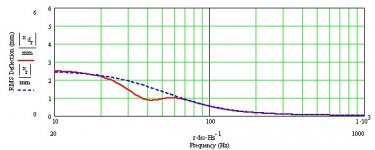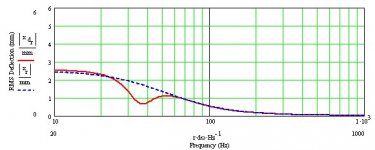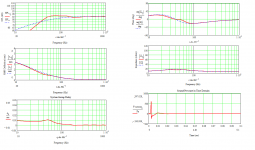I did assess the E100HD+, which is essentially the same as HD but higher sensitivity. Currently using the Eikona. The former is a tweaked 92 with raised upper response curve and more responsive surround as well as higher sensitivity. I found the performance on the whole to be on a par with the 92 but the raised HF was not suitable for my designs and seemed to emphasise the 'breakup' region.
Eikona is a different beast entirely (only the cone is the same but with phase plug). More expensive but on the whole an improvement in several ways (clarity, detail, bass).
Eikona is a different beast entirely (only the cone is the same but with phase plug). More expensive but on the whole an improvement in several ways (clarity, detail, bass).
Thanks for the info Kevin.
I would want to use just a single driver (per speaker), without a tweeter but also without top-end harshness. Would you say that the Eikona would be a better bet ?
Also, judging by the photos at least, the E100HD seems to have less available cone travel due to the roll surround than the Eikona ? Although both drivers are spec'd with a similar Xmax (+/-4.5 and 5mm), only the Jordan unit specs the Xmech (+/-10mm), so I wonder if it would actually be better in terms of bass performance ?
I would want to use just a single driver (per speaker), without a tweeter but also without top-end harshness. Would you say that the Eikona would be a better bet ?
Also, judging by the photos at least, the E100HD seems to have less available cone travel due to the roll surround than the Eikona ? Although both drivers are spec'd with a similar Xmax (+/-4.5 and 5mm), only the Jordan unit specs the Xmech (+/-10mm), so I wonder if it would actually be better in terms of bass performance ?
Hi CS,
Interesting question. I would say yes the Eikona is better quality in the top end but volume is not not so pronounced and may apear to roll-off. The raise in HF in the 92 attempts to counteract off-axis rolloff. Personally I think the best solution for you would be the Eikona (if you can afford it) but if you are running without tweeter then you may need an amp with tone controls to raise the HF a bit, especially if listened to off axis. Why have tone controls dissappeared off 'hi-end' amps for God's sake??
Yes the excusion quoted for Eikona is twice that of the 92. Actually the coil is a different design (overhung rather than underhung) so it will compress bass volume near the limit, while the 92 will suddenly become distorted due to the coil starting to move out of the field. On the whole I think the former is a better solution as degradation is more 'graceful'. Yes I have noticed much better bass volume capability with the Eikona but not necessarily much improvement in extension (after all its only about 4Hz lower in Fo than original 92).
Interesting question. I would say yes the Eikona is better quality in the top end but volume is not not so pronounced and may apear to roll-off. The raise in HF in the 92 attempts to counteract off-axis rolloff. Personally I think the best solution for you would be the Eikona (if you can afford it) but if you are running without tweeter then you may need an amp with tone controls to raise the HF a bit, especially if listened to off axis. Why have tone controls dissappeared off 'hi-end' amps for God's sake??
Yes the excusion quoted for Eikona is twice that of the 92. Actually the coil is a different design (overhung rather than underhung) so it will compress bass volume near the limit, while the 92 will suddenly become distorted due to the coil starting to move out of the field. On the whole I think the former is a better solution as degradation is more 'graceful'. Yes I have noticed much better bass volume capability with the Eikona but not necessarily much improvement in extension (after all its only about 4Hz lower in Fo than original 92).
Hi Kevin,
Thanks very much for the useful input.
Whichever driver I end up with, my intention is to use them in a slim column MLTL design. Putting the Eikona parameters into the MJK ported worksheet shows very promising results with a cabinet 160 x 230 x 900mm (W x D x H). I have deliberately gone for a fairly modest LF extension (~ 42Hz -3dB) so as not to increase cone excursion too much.
I also plan to make them 'powered' (built-in power amps) so that the baffle step correction can be implemented actively at line level, and they can then be driven from a small unobtrusive preamp.
Thanks very much for the useful input.
Whichever driver I end up with, my intention is to use them in a slim column MLTL design. Putting the Eikona parameters into the MJK ported worksheet shows very promising results with a cabinet 160 x 230 x 900mm (W x D x H). I have deliberately gone for a fairly modest LF extension (~ 42Hz -3dB) so as not to increase cone excursion too much.
I also plan to make them 'powered' (built-in power amps) so that the baffle step correction can be implemented actively at line level, and they can then be driven from a small unobtrusive preamp.
Ok but not sure about your rationale about higher tuning reducing excursion. Excursion is lowest at the tuning frequency and since it is more of an issue the lower the input frequency, the lower the tuning frequency the better with the constraints of useable response, (unless the room can't handle it of course). There is a handy calculator to show room response capability on web somewhere.
Hi Kevin,
I have attached two slightly different port tuning responses in terms of cone excursion, by varying the port diameter. For the lowest tuning, the excursion 'bounces back' more as you go above the tuning frequency.
In effect, as the tuning frequency is lowered, the frequency range over which there is useful excursion reduction gets less. The region just above the tuning point where there is little excursion reduction broadens out.
I have attached two slightly different port tuning responses in terms of cone excursion, by varying the port diameter. For the lowest tuning, the excursion 'bounces back' more as you go above the tuning frequency.
In effect, as the tuning frequency is lowered, the frequency range over which there is useful excursion reduction gets less. The region just above the tuning point where there is little excursion reduction broadens out.
Attachments
The main benefit of a higher tuning is to reduce cone excursion in the octave above Fb. Since in most rock music etc., the LF energy is typically concentrated in the ~ 60Hz - 120Hz region, a 40Hz Fb for e.g. can place the greatest power demands slap bang in the middle of the region where the driver is already working hardest. Of course, the tradeoff is that you're unloading at a higher frequency. In some of my MLTL alignments, e.g. the pensils I did for the MA drivers and the box I did for the Eikona, I go for a modest Fb (high 50Hz regions) with a quasi pro-audio alignment, but use fairly extensive damping similar to that in a 'regular' TL, giving a fairly unreactive impedance load & linear driver excursion, which goes some way to compensating for this.
Last edited:
Hi CS,
I can see from your graphs that in tuning lower you are actually providing a greater limit to excursion but over a less broad frequency range. Its swings and roundabouts. I would rather have the lower tuning frequency as long as you get a more extended flat frequency plot. Tuning should be for frequency extension, not excursion limitation. Yes most bass is in the higher region but then again problems with excusion become much more prominent with lower frequency so you need to cater for the lower end of the bass spectrum disproportionately and that is what your lower tuning does. If you want to be serious about limiting excursion then the best approach would be a high pass filter. If you are playing at such a volume that excursion is an issue at 40Hz then I can guarantee as soon as you hit some subsonic frequencies you will get some very nasty behaviour.
Regarding the question about cymbals yes they do sound very good. best placement I find is toed in so axis crosses over infront of the listener but like I say treble assistance may be necessary.
I can see from your graphs that in tuning lower you are actually providing a greater limit to excursion but over a less broad frequency range. Its swings and roundabouts. I would rather have the lower tuning frequency as long as you get a more extended flat frequency plot. Tuning should be for frequency extension, not excursion limitation. Yes most bass is in the higher region but then again problems with excusion become much more prominent with lower frequency so you need to cater for the lower end of the bass spectrum disproportionately and that is what your lower tuning does. If you want to be serious about limiting excursion then the best approach would be a high pass filter. If you are playing at such a volume that excursion is an issue at 40Hz then I can guarantee as soon as you hit some subsonic frequencies you will get some very nasty behaviour.
Regarding the question about cymbals yes they do sound very good. best placement I find is toed in so axis crosses over infront of the listener but like I say treble assistance may be necessary.
Last edited:
Not so. It depends on the specific design. Here's one I did when the Eikona specs. were first released. It's an alignment I like and regularly use; it's not tuned for maximum LF extension, but to provide a more broadband gain through the midbass, while the extensive damping provides a near-flat impedance load (and very linear driver deflection). Despite the higher than usual Fb, RMS driver excursion is still only 1.6mm at 30Hz.
Under the majority of practical conditions that a 5in wideband driver is likely to be used in, combined with the slight lift evidently built into the Eikona's anechoic FR, it should go a good way to compensating for step-loss.
Under the majority of practical conditions that a 5in wideband driver is likely to be used in, combined with the slight lift evidently built into the Eikona's anechoic FR, it should go a good way to compensating for step-loss.
Attachments
Hi CS,
I can see from your graphs that in tuning lower you are actually providing a greater limit to excursion but over a less broad frequency range. Its swings and roundabouts. I would rather have the lower tuning frequency as long as you get a more extended flat frequency plot. Tuning should be for frequency extension, not excursion limitation. Yes most bass is in the higher region but then again problems with excusion become much more prominent with lower frequency so you need to cater for the lower end of the bass spectrum disproportionately and that is what your lower tuning does....
Hi Kevin,
The reason that the higher tuning frequency shows a less deep notch is that I applied a small amount of damping to the port to maintain an overall flat frequency response. 20% or the port length is damped at the same density as the rest of the cabinet, whereas the lower port tuning doesn't need any port damping.
I guess the tuning strategy depends on your taste in music. For me, it's mainly rock/blues, so most of the bass is in the 70-100Hz region. Therefore, reducing the excursion at a higher than normal frequency will be beneficial in reducing intermodulation, but I take your point that subsonic energy could cause a problem.
I have also tried putting the Eikona parameters into Martin's TL worksheet, but wasn't able to significantly broaden the excursion reduction bandwidth compared to an MLTL.
Chris.
Has anyone had the opportunity to compare these two drivers ?
Both seem to have improved performance compared to the JX92S from which they are both derived.
I'd be interested in a straight shootout between these two drivers in the same enclosure design.
Anyone know if the Eikona is available de-branded or perhaps with custom phase plug?
I'd be interested in a straight shootout between these two drivers in the same enclosure design.
Yes, done this - the Eikona has less treble resonance as supported by the waterfall plot compared to 92. Less baffle-step correction needed also because of the more balance response curve. These two factors together means treble is less prominent, however and may seem subdued on first listen, but you are talking about even greater detail resolution. There is not a vast difference in the bass. The Eikona is slightly better but in a loaded design there is a very slight air leak through the voicecoil around system resonance (past the phase plug) that can just be heard in frequency testing - not a major issue and Ted may even address this in future versions. I really do love the sound of the Eikona, particularly the more natural sound it affords violins and female voices.
If I can sum up what I like about this (successful) design I think it is the ability to render interesting waveforms coherently. Take a 'musical' bass note for instance that is a non-sine wave so contains may upper harmonics. Producing these cleanly and coherent with one another means the waveform is ultimately preserved to a much higher degree than would be afforded by say a 2-way design. The 'cleanliness' has to be good enough to justify the approach and so gain all the advantages predicted by the 'theory' and the Eikona does it beautifully to my ears. Not to say the 92 does not do it very well also.
I was trying to convey this point to a retailer recently and he pointed out that a large bass driver in a sealed container must do a square wave more effectively. This is a common misconception as you need a substantial contributing high-frequency component to approximate a square wave (or any interesting waveform) and a dedicated bass driver (however powerful) won't do it. Add a tweeter and you get a good approximation. Use a Jordan and you are talking!
What a large bass driver does do is allow a sealed enclosure that affords the best transient response to the lowest frequencies. With the Jordan substantial cabinet loading is the only way to do it prorperly and a transmission line is the favoured approach for transient response. The only disadvantage is that the amp has to cope with the increased demand in the lower bass but with modern high powered solid state it's really not an issue. You end up with a neat modest sized cabinet that can outshine just about any other design out there except in the very lowest bass and even there the shortfall need only be minimal unless your priority is reproducing wall-shaking earthquakes rather than music! Actually I can even produce the earthquakes realistically, I just don't get the walls fracturing - probably a good thing
Last edited:
Basically, no, as you you can't 'clean up' waterfall response. There are some fundamental properties of the sound of speakers that are irriversible and some that are reversible. Frequency smoothness can be tweaked but distortion, waterfall, volume envelope (increase) - forget it! Otherwise you would ust buy the cheapest driver and process out all the noise with electronics. Oh if hi-fi was as simple as that!
Is it worth the increased cost? Depends on the preferences and discernment capabilty of the individual. It's a good question as there comes a point with any hi-fi where you get diminishing returns with additional cost to the extent that it's beyond human resoltion. The truth is that speaker drivers are so bad at resolution compared to everything else in the electronics chain that money spent here is usually worthwhile. For my money - yes it is worth it. Put it this way it's debatable whether you could improve on the waterfall response of the Eikona and still hear the difference. Not so with the 92/E100HD version.
Incidentally I have 4 E100HD+ for sale if anyone interested. Hardly used and do sound great.
Is it worth the increased cost? Depends on the preferences and discernment capabilty of the individual. It's a good question as there comes a point with any hi-fi where you get diminishing returns with additional cost to the extent that it's beyond human resoltion. The truth is that speaker drivers are so bad at resolution compared to everything else in the electronics chain that money spent here is usually worthwhile. For my money - yes it is worth it. Put it this way it's debatable whether you could improve on the waterfall response of the Eikona and still hear the difference. Not so with the 92/E100HD version.
Incidentally I have 4 E100HD+ for sale if anyone interested. Hardly used and do sound great.
- Status
- This old topic is closed. If you want to reopen this topic, contact a moderator using the "Report Post" button.
- Home
- Loudspeakers
- Full Range
- Jordan Eikona vs EAD E100HD


